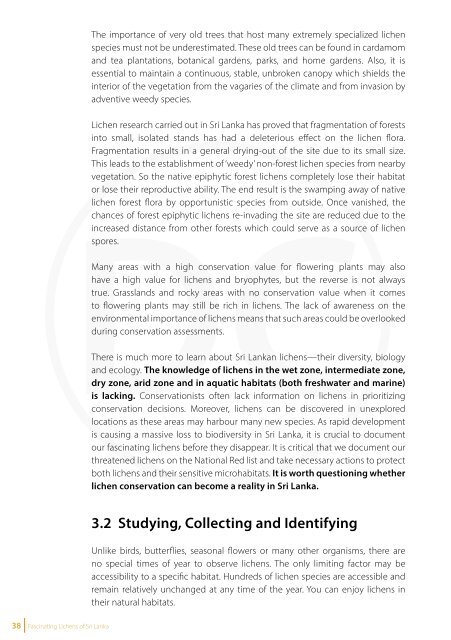You also want an ePaper? Increase the reach of your titles
YUMPU automatically turns print PDFs into web optimized ePapers that Google loves.
38 <strong>Fascinating</strong> <strong>Lichens</strong> <strong>of</strong> <strong>Sri</strong> <strong>Lanka</strong><br />
The importance <strong>of</strong> very old trees that host many extremely specialized lichen<br />
species must not be underestimated. These old trees can be found in cardamom<br />
and tea plantations, botanical gardens, parks, and home gardens. Also, it is<br />
essential to maintain a continuous, stable, unbroken canopy which shields the<br />
interior <strong>of</strong> the vegetation from the vagaries <strong>of</strong> the climate and from invasion by<br />
adventive weedy species.<br />
Lichen research carried out in <strong>Sri</strong> <strong>Lanka</strong> has proved that fragmentation <strong>of</strong> forests<br />
into small, isolated stands has had a deleterious effect on the lichen flora.<br />
Fragmentation results in a general drying-out <strong>of</strong> the site due to its small size.<br />
This leads to the establishment <strong>of</strong> ‘weedy’ non-forest lichen species from nearby<br />
vegetation. So the native epiphytic forest lichens completely lose their habitat<br />
or lose their reproductive ability. The end result is the swamping away <strong>of</strong> native<br />
lichen forest flora by opportunistic species from outside. Once vanished, the<br />
chances <strong>of</strong> forest epiphytic lichens re-invading the site are reduced due to the<br />
increased distance from other forests which could serve as a source <strong>of</strong> lichen<br />
spores.<br />
Many areas with a high conservation value for flowering plants may also<br />
have a high value for lichens and bryophytes, but the reverse is not always<br />
true. Grasslands and rocky areas with no conservation value when it comes<br />
to flowering plants may still be rich in lichens. The lack <strong>of</strong> awareness on the<br />
environmental importance <strong>of</strong> lichens means that such areas could be overlooked<br />
during conservation assessments.<br />
There is much more to learn about <strong>Sri</strong> <strong>Lanka</strong>n lichens—their diversity, biology<br />
and ecology. The knowledge <strong>of</strong> lichens in the wet zone, intermediate zone,<br />
dry zone, arid zone and in aquatic habitats (both freshwater and marine)<br />
is lacking. Conservationists <strong>of</strong>ten lack information on lichens in prioritizing<br />
conservation decisions. Moreover, lichens can be discovered in unexplored<br />
locations as these areas may harbour many new species. As rapid development<br />
is causing a massive loss to biodiversity in <strong>Sri</strong> <strong>Lanka</strong>, it is crucial to document<br />
our fascinating lichens before they disappear. It is critical that we document our<br />
threatened lichens on the National Red list and take necessary actions to protect<br />
both lichens and their sensitive microhabitats. It is worth questioning whether<br />
lichen conservation can become a reality in <strong>Sri</strong> <strong>Lanka</strong>.<br />
3.2 Studying, Collecting and Identifying<br />
Unlike birds, butterflies, seasonal flowers or many other organisms, there are<br />
no special times <strong>of</strong> year to observe lichens. The only limiting factor may be<br />
accessibility to a specific habitat. Hundreds <strong>of</strong> lichen species are accessible and<br />
remain relatively unchanged at any time <strong>of</strong> the year. You can enjoy lichens in<br />
their natural habitats.<br />
There are many lichens just sitting in your back yard which you may have<br />
never noticed.<br />
Although pr<strong>of</strong>essional lichenologists insist on collections for identification in<br />
the lab for scientific purposes, most <strong>of</strong> us will never have the need to collect<br />
lichens. Leave them right where they grow best and enjoy them. Close<br />
up photography and sketching will help produce tangible memories <strong>of</strong> your<br />
experience.<br />
Never collect lichens from protected areas without a permit. Also do not collect<br />
these slow growing organisms, unless you need them for a scientific purpose.<br />
A hand lens is the single most important tool to have with you (10X jewellers<br />
lens), which will make it easy to see most <strong>of</strong> the obvious characteristics <strong>of</strong><br />
lichens. Most <strong>of</strong> the macrolichens can be told apart by their general appearance.<br />
The macrolichens included in this book are very easy to identify, just by using a<br />
hand lens in the natural habitats. However, a majority <strong>of</strong> microlichens, especially<br />
crustoses can only be identified through the careful study <strong>of</strong> their microscopic<br />
characteristics, the number and type <strong>of</strong> spores, detail <strong>of</strong> the ascus structure, and<br />
so forth. Every so <strong>of</strong>ten, thin-layer chromatography (TLC) is needed to identify<br />
the lichen compounds more thoroughly.<br />
You need to pay close attention when you collect for scientific purposes. It will<br />
leave a scar when gathering crustose species, as it can only be collected by<br />
removing some <strong>of</strong> the substrate. This can only be done by using a knife or a<br />
chisel. To obtain lichens found on rocks, the collector may even need a hammer<br />
and cold chisel. Once collected, specimens should be kept in folded paper<br />
packets (not plastic bags) because lichens need to be kept dry or they will rot.<br />
Even experts <strong>of</strong>ten have trouble naming lichens with confidence, because the<br />
range <strong>of</strong> variation within a species can make it resemble closely related ones.<br />
More and more, lichenologists are using molecular methods and statistical<br />
methods <strong>of</strong> revealing evolutionary relationships to circumscribe genera and<br />
species. However, none <strong>of</strong> this should discourage readers who want to try<br />
their hand at serious identification. There are good sources <strong>of</strong> help beyond this<br />
primary guide book for anyone who wants to dig deeper. Access to a good<br />
dissecting tool, a compound microscope, and few easily obtainable chemicals<br />
can take you to higher level.<br />
Like many other groups <strong>of</strong> organisms, some lichen species are common while<br />
some species are rare to very rare. Currently there is no organization or institution<br />
that is working to identify extremely uncommon or endangered lichens species<br />
in <strong>Sri</strong> <strong>Lanka</strong>. Furthermore, the true evolutionary relationships among species <strong>of</strong><br />
lichen fungi are just beginning to be worked out, so the classification <strong>of</strong> lichen<br />
<strong>Fascinating</strong> <strong>Lichens</strong> <strong>of</strong> <strong>Sri</strong> <strong>Lanka</strong> 39















